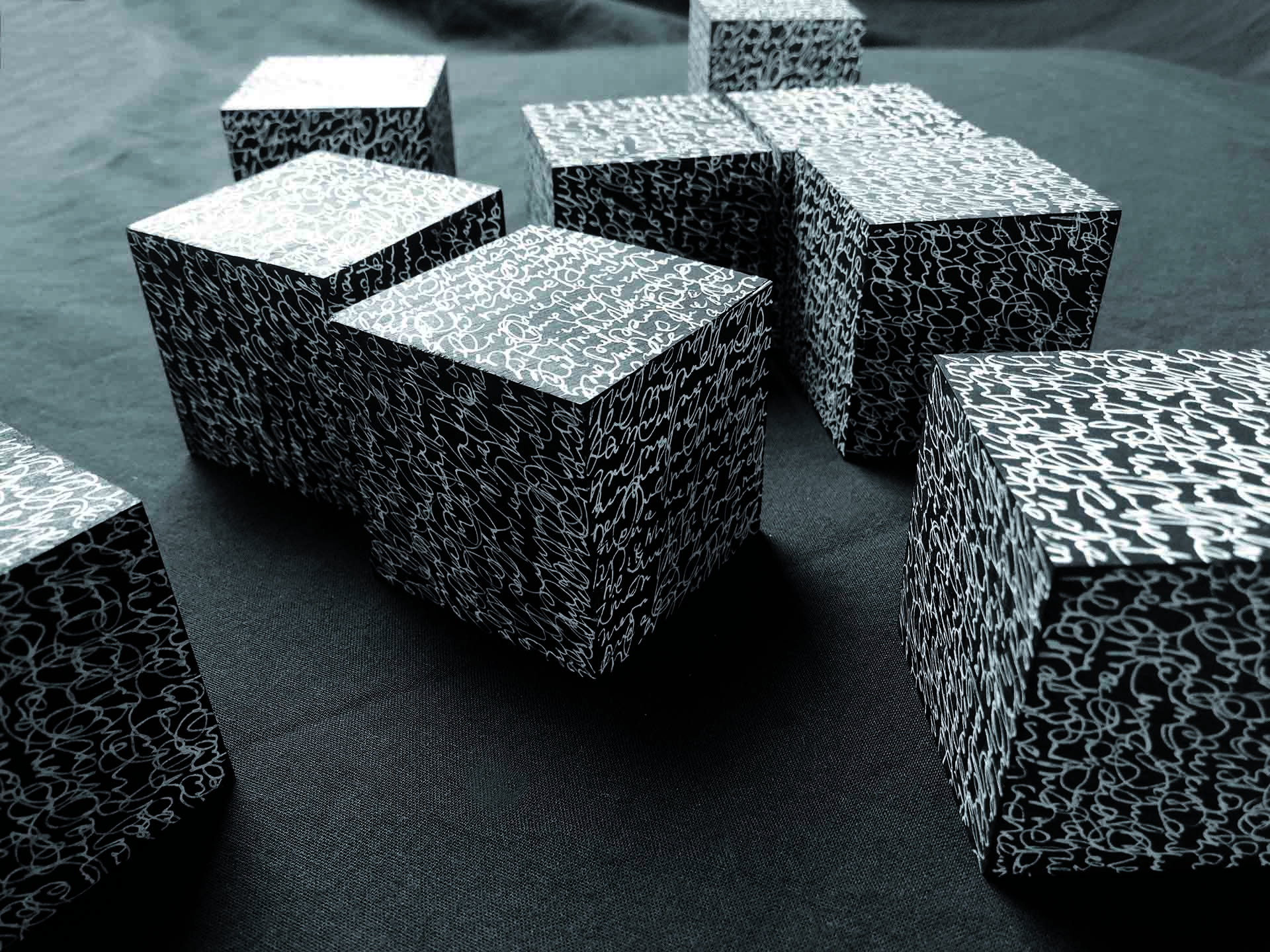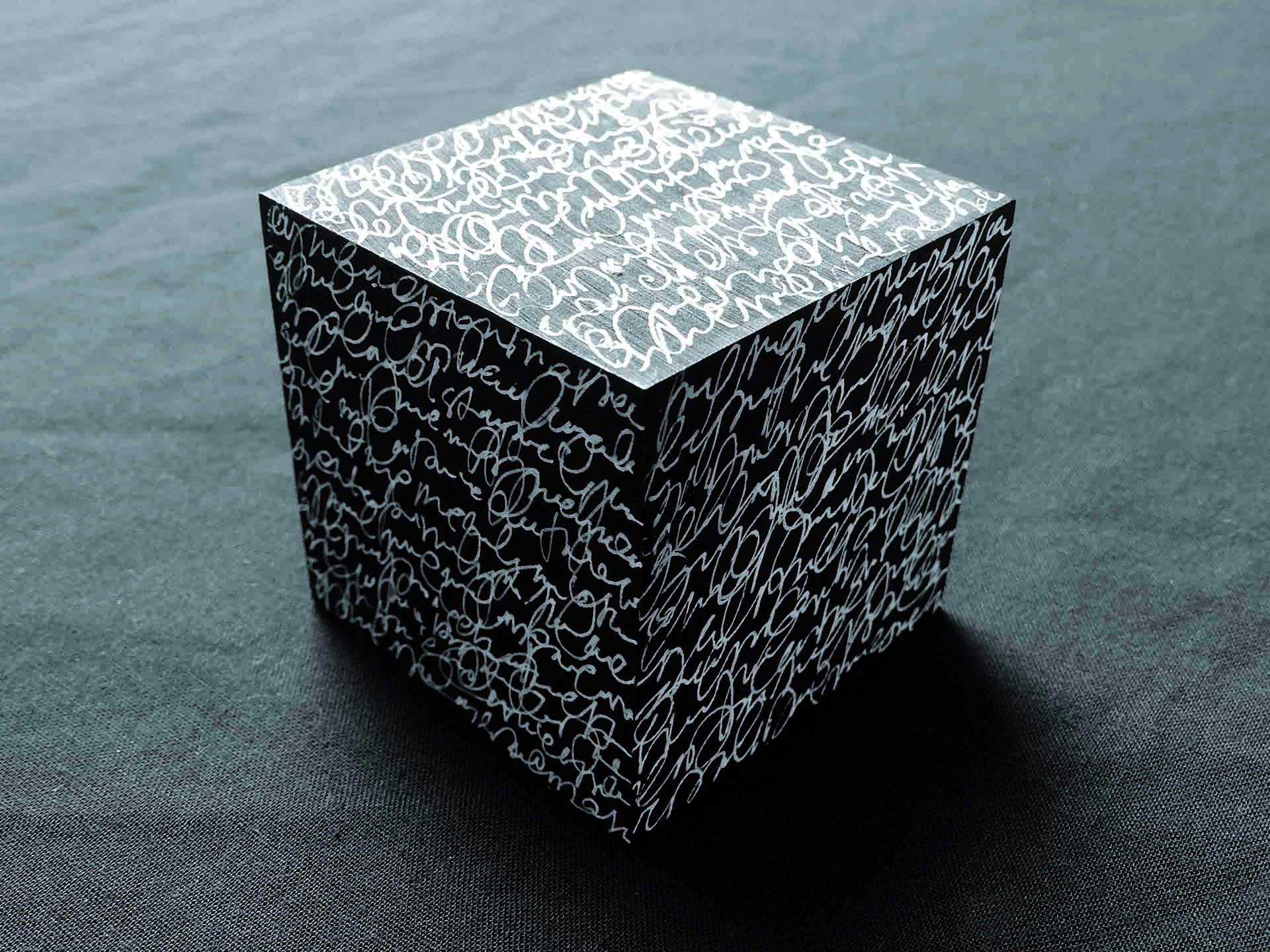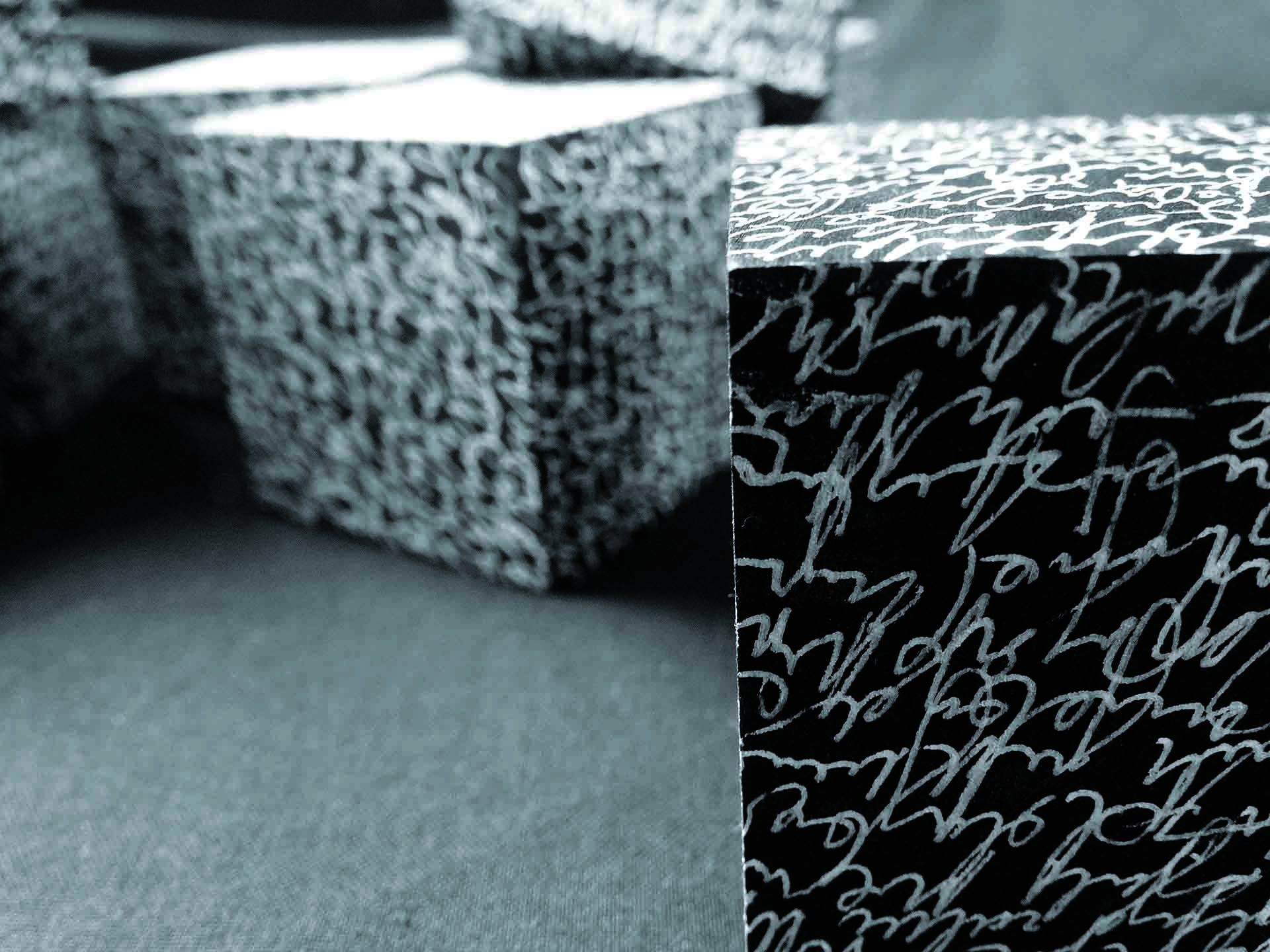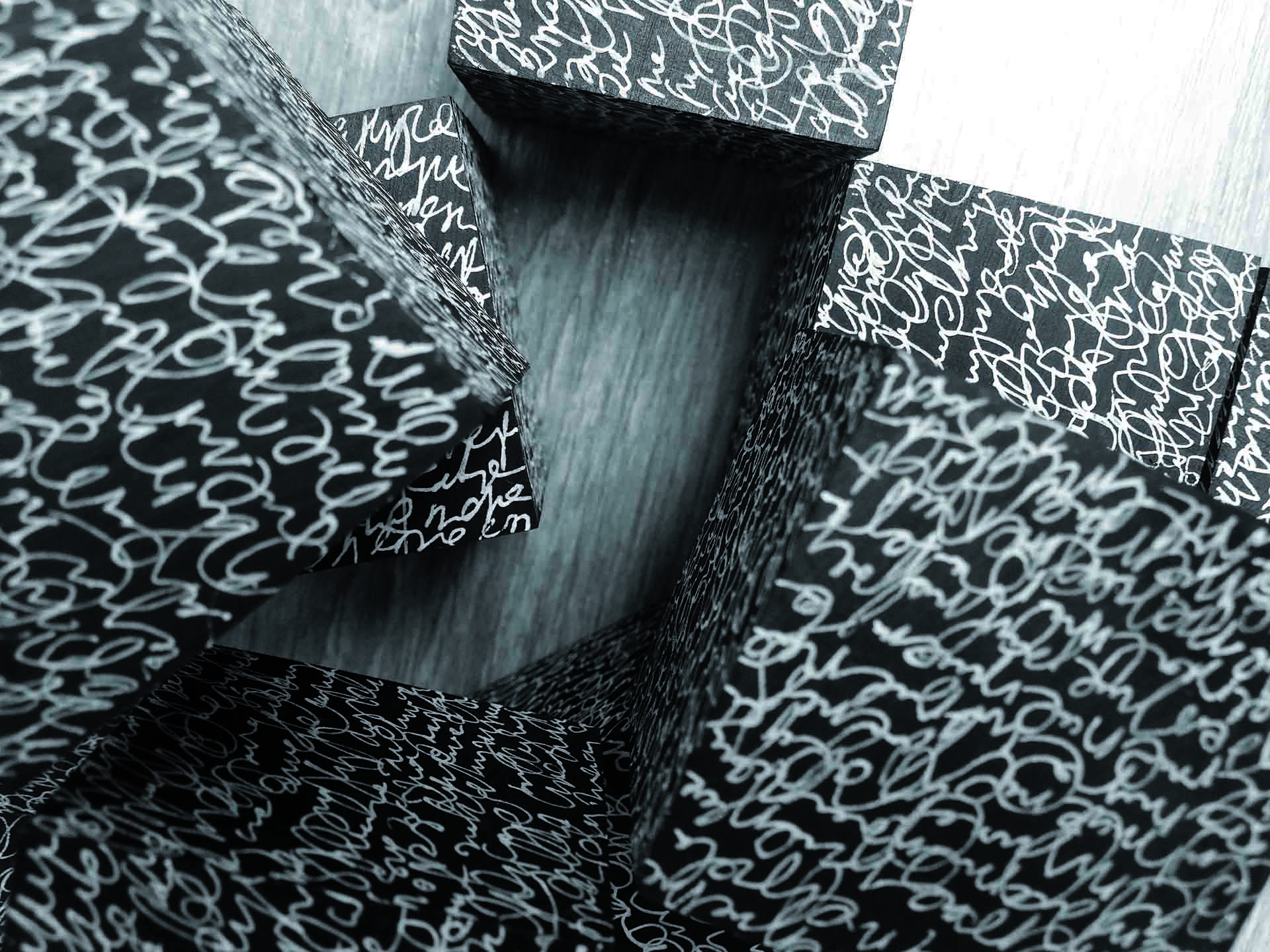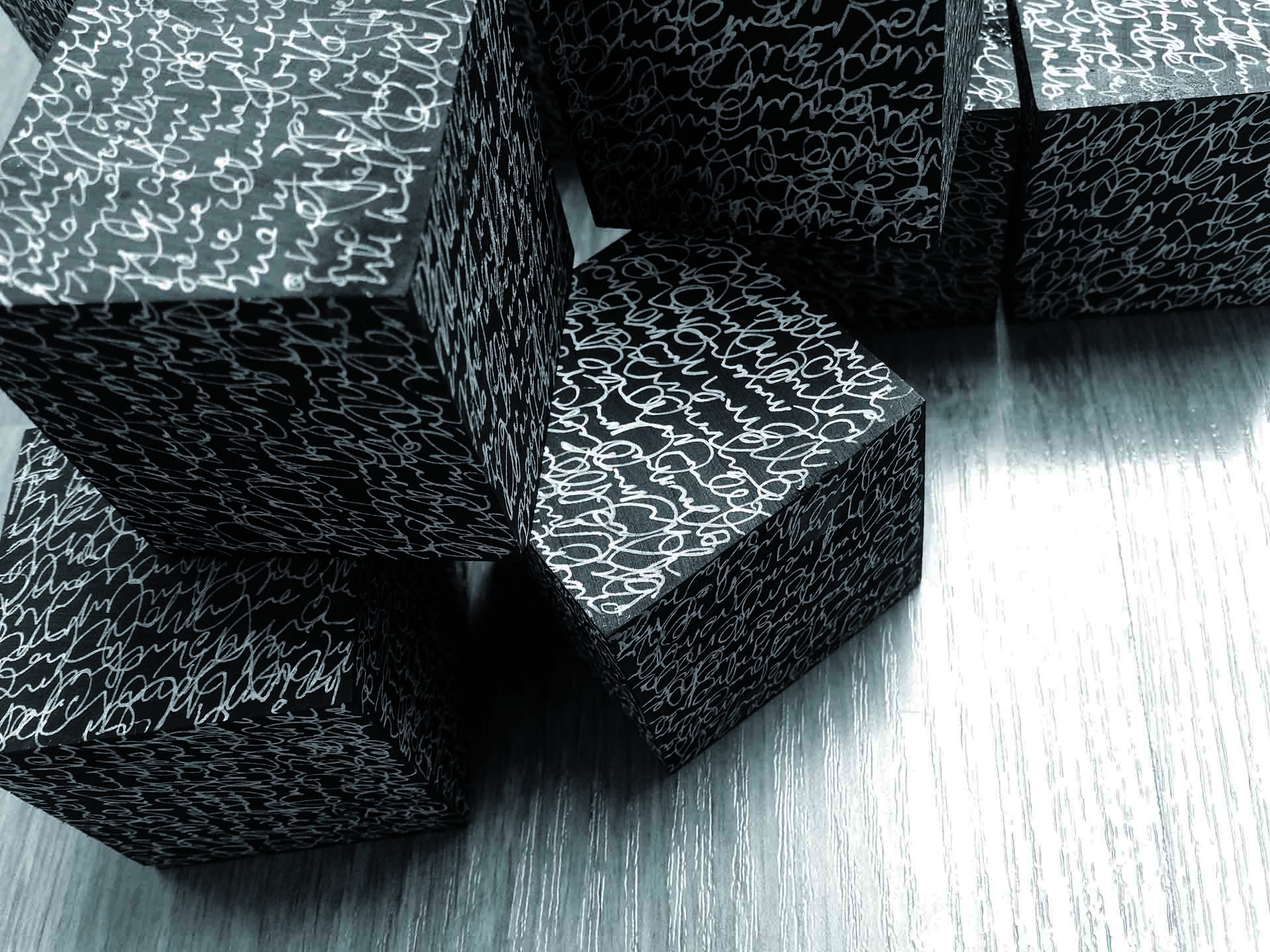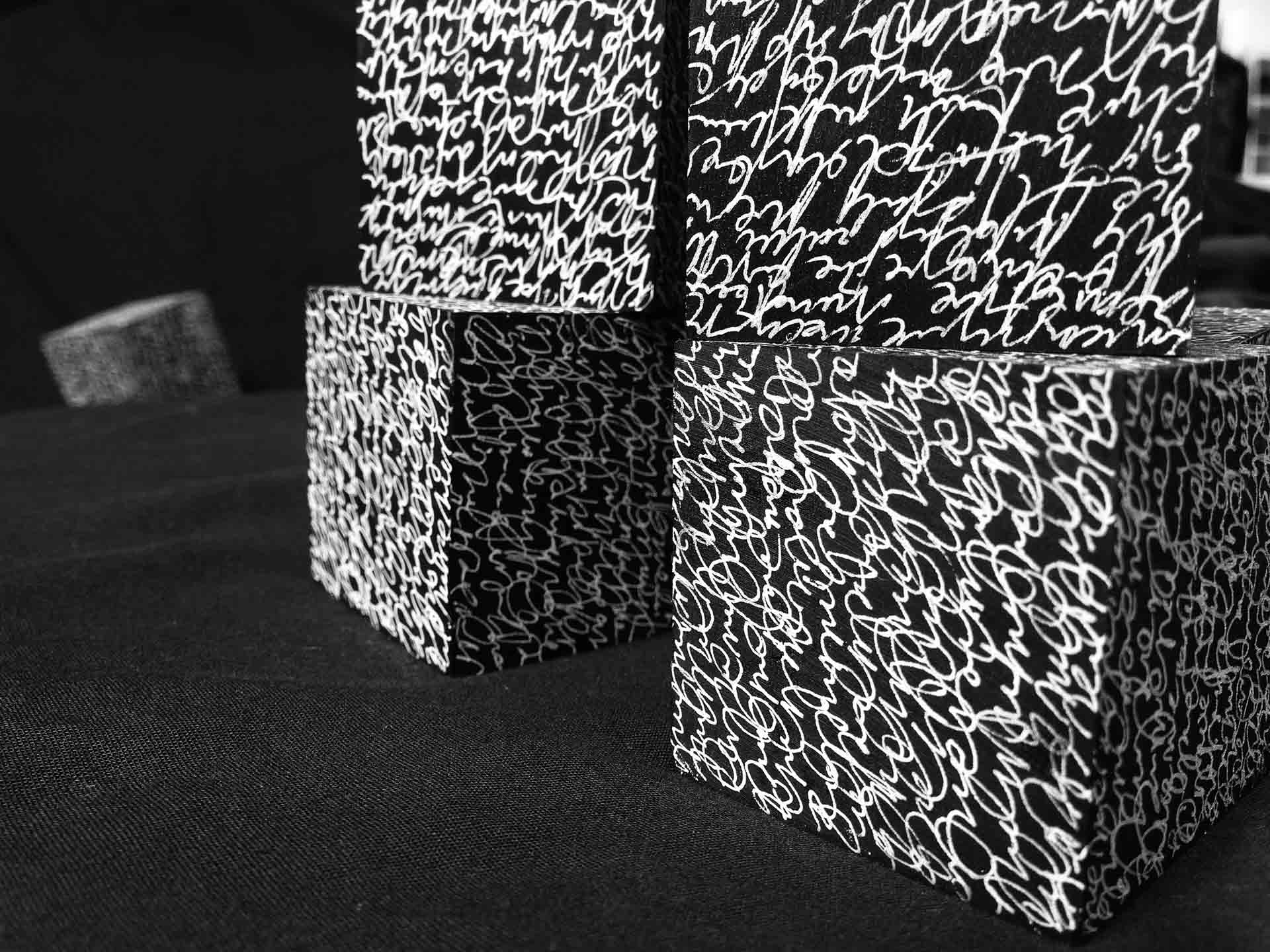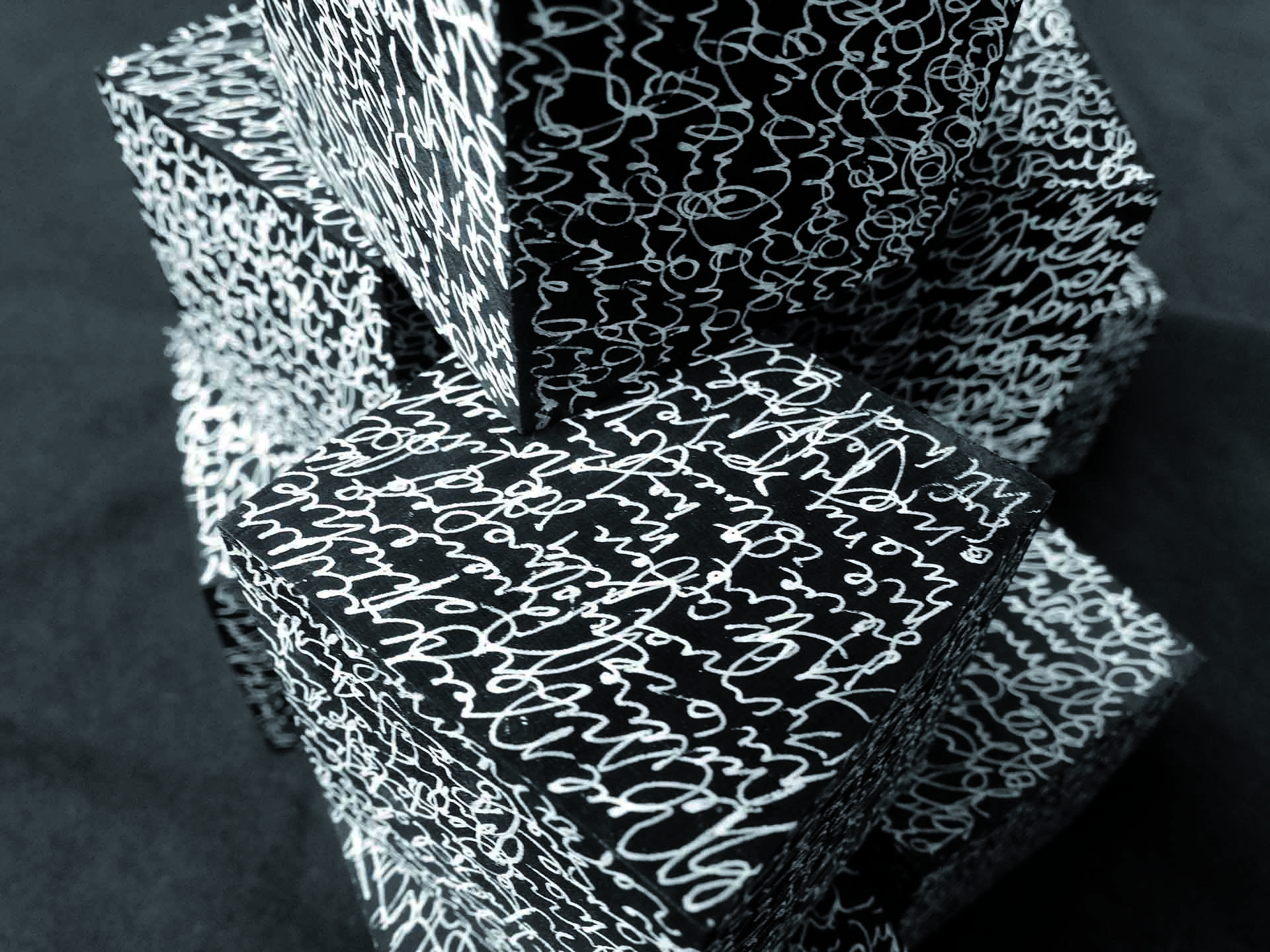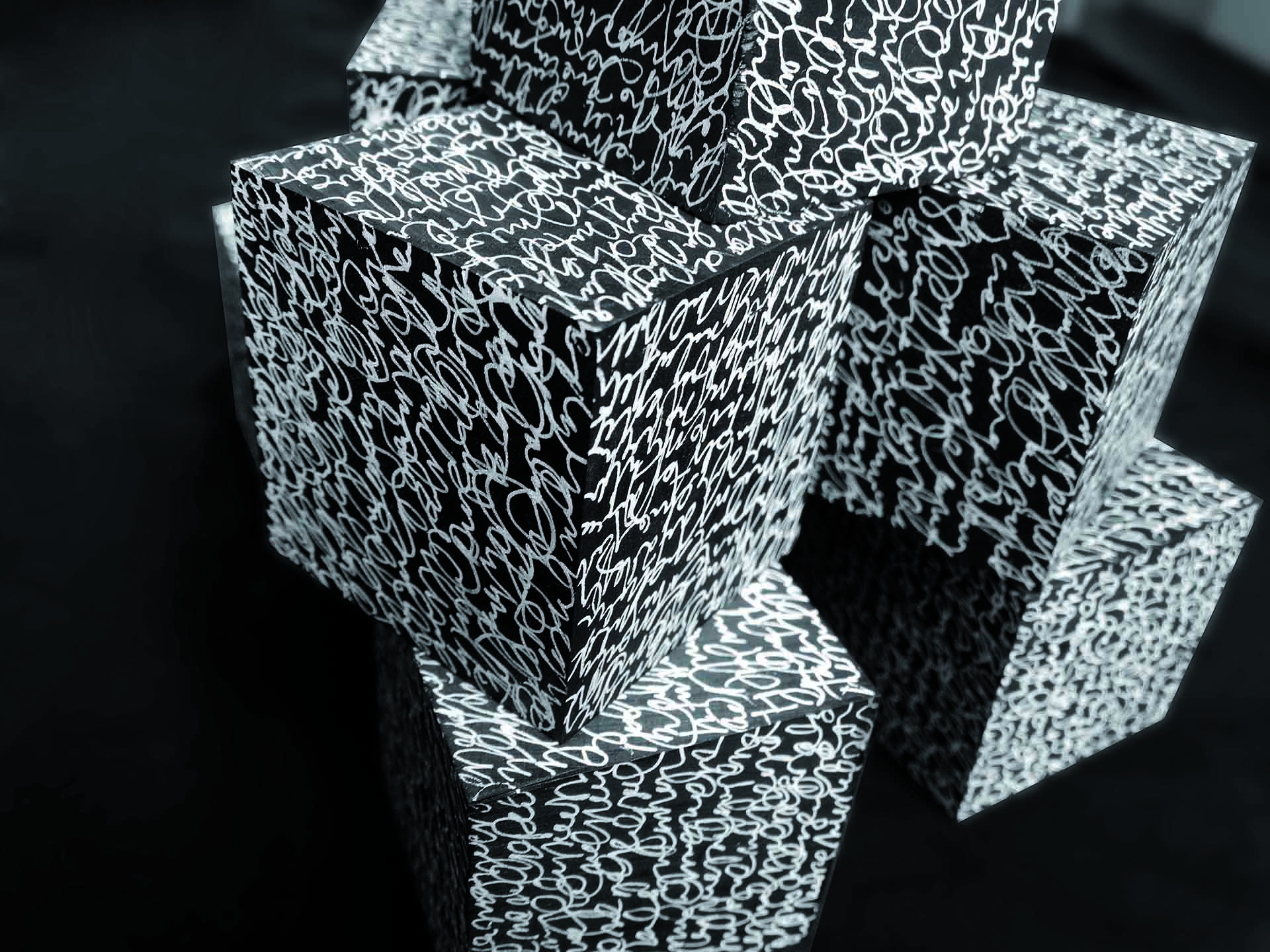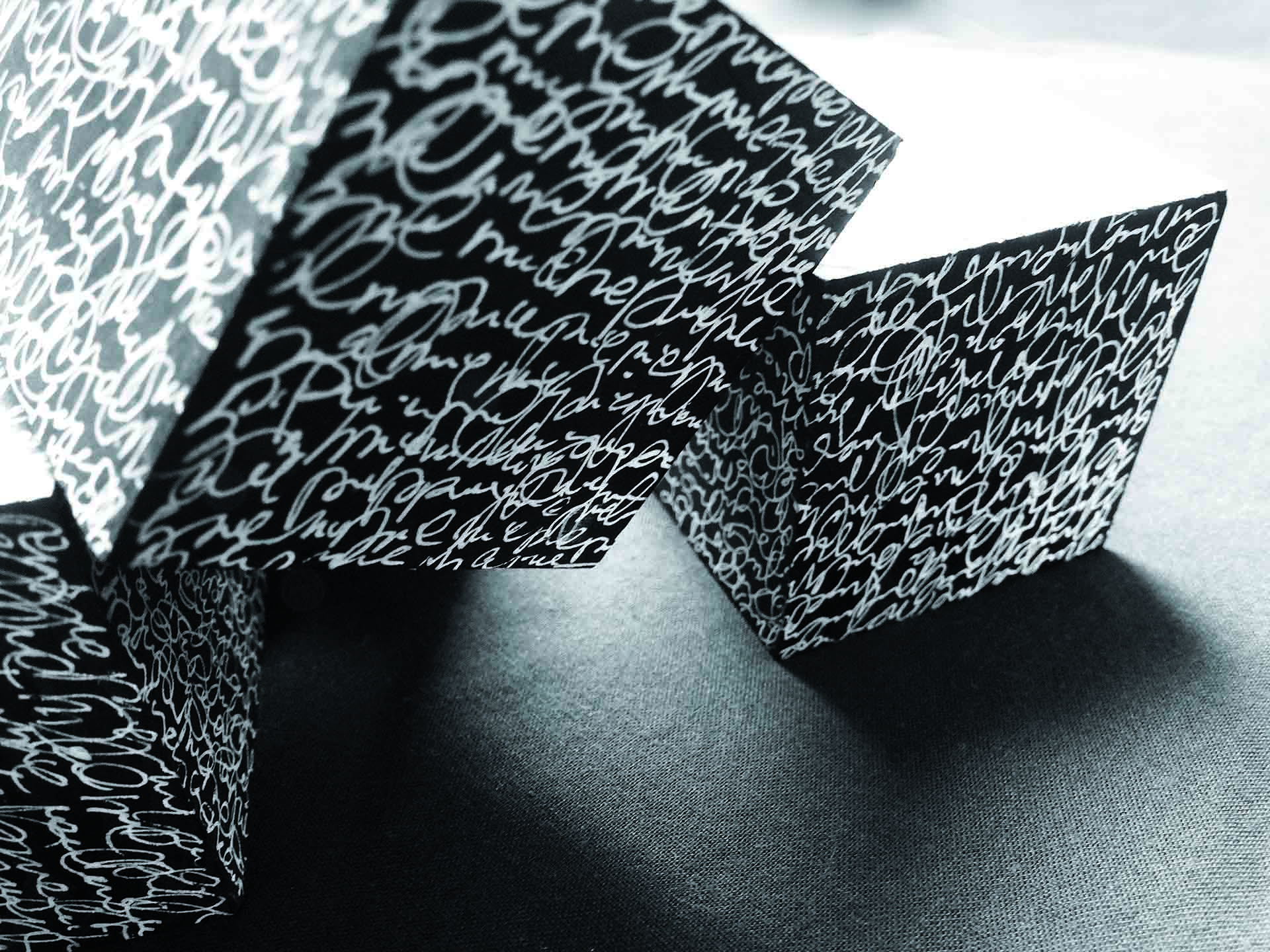
Calligraphic Cubes / Sześciany kaligraficzne (2018). CUBES
From the cycle / z cyklu: ASEMIC WRITING
Calligraphic Cubes, 2018, 9 pieces, 7×7×7 cm
wood, acrylic
Sześciany kaligraficzne, 2018, 9 sztuk, 7×7×7 cm
drewno, akryl
-[ENG]
Calligraphic Cubes / Sześciany kaligraficzne (2018)
The Calligraphic Cubes series was created in 2018 as part of the long-term project Asemic Writing, which investigates the boundaries of communication, the structure of the sign, and its material presence in space. The project stems from the conviction that writing does not have to serve exclusively informational or referential functions. It may exist as a visual, rhythmic, and spatial form, opening new fields of perception.
Within the series, two sculptural sets made of wood were created. In both cases, asemic inscriptions act as activators of imagination and instruments for shifting perception. The modular form of the cubes opens a field of interaction: the viewer may perceive them either as individual objects or as parts of a larger structure in which repetition, rhythm, and tension become visible.
The first set consists of 12 wooden cubes, each measuring 7 × 7 × 7 cm, painted black and inscribed by hand with white ink. Each cube is unique – an autonomous unit of asemic expression – in which the surface becomes a field for the rhythm of the hand, the repetition of gestures, and the micro-accidents that arise from the physicality of the material. The artist treats them both as self-contained objects of contemplation and as elements of spatial compositions – a kind of alphabet without fixed meaning, where letters are replaced by untranslatable signs.
Encountering a single cube, the viewer experiences its materiality and the rhythm of inscription. When combined with others, the cubes can form “words” or “sentences,” yet they never achieve unambiguous sense. Here, tension emerges: between order and the potential for coding on one hand, and asemanticity and unreadability on the other.
The second set comprises 27 smaller cubes (5 × 5 × 5 cm), which together form a complete 3 × 3 × 3 module. In this case, the asemic sign is multiplied and proliferated, generating a kind of three-dimensional palimpsest. The writing circulates around the geometric form, wrapping all its surfaces. The inscription has no beginning and no end; it seems to pulsate endlessly, creating the illusion of movement.
This form evokes multiple associations: mystical dice, models of logical languages, archetypal mathematical structures, and objects rooted in conceptual art, where systems and repetition constitute the foundation of the work. At the same time, the presence of hand-made inscriptions – imperfect, varied, marked by the energy of gesture – introduces an element of corporeality and intimacy. This is not a sterile mathematical figure but a structure infused with traces of action, errors, and the rhythm of breathing.
The composition was presented under the title Calligraphic Cubes – Endemite, emphasizing its unique and unrepeatable character. Like endemic species in nature that exist only in specific places and times, these cubes embody a singular, unrepeatable record of gesture that cannot be recreated or copied.
The Calligraphic Cubes project operates at the intersection of sculpture, writing, and sign. Each cube is a carrier of inscription and, at the same time, part of a larger structure. The work poses a fundamental question: what remains of language when its referential function is stripped away? The answer is asemia, which allows writing to be understood as pure visual form, rhythm, gesture, and ornament.
At the same time, Calligraphic Cubes is also an attempt to embody writing – to give it three-dimensional presence, weight, shadow, and light. The sign ceases to be an abstraction on paper and becomes a material object that can be held, rotated, combined, or dispersed in space. Writing becomes tangible, entering into dialogue with architecture and environment, constantly changing depending on the mode of display.
In exhibitions, the cubes were presented in two distinct modes:
1. As an integrated sculptural structure, where modularity emphasized the sense of system and order.
2. As dispersed elements, resembling artifacts or fragments of an unknown alphabet.
These two modes of display highlighted the tension between order and chaos, structure and movement, system and fragmentation. The audience could interpret the cubes as mystical objects, logical systems, or remnants of a forgotten culture.
The Calligraphic Cubes project transcends the boundaries of classical sculpture. It is not merely a visual form but also a philosophical proposition: a reflection on the limits of language and on how signs function when they are deprived of meaning. It is also a question posed to the viewer – can we engage with writing that cannot be read?
The cubes, like asemic signs, remain in a suspended state: they are simultaneously works of art, fragments of a non-existent language, and material traces of gesture. This tension makes the Calligraphic Cubes project exceptional – open, multivalent, and resistant to unambiguous classification.
[PL]
Sześciany kaligraficzne / Calligraphic Cubes (2018)
Cykl Sześciany kaligraficzne powstał w 2018 roku jako część długoterminowego projektu Asemic Writing, którego celem jest badanie granic komunikacji, struktury znaku i jego materialnej obecności w przestrzeni. Projekt wyrasta z przekonania, że pismo nie musi pełnić wyłącznie funkcji informacyjnej i referencyjnej, ale może istnieć jako forma wizualna, rytmiczna i przestrzenna, otwierająca nowe pole percepcji.
W ramach cyklu powstały dwa zestawy rzeźbiarskie wykonane z drewna, w których asemiczne zapisy pełnią rolę aktywatorów wyobraźni i narzędzi zmiany spojrzenia. Modularna forma sześcianów otwiera pole do interakcji: widz może je postrzegać zarówno jako indywidualne obiekty, jak i jako część większej struktury, w której ujawnia się gra powtórzeń, rytmów i napięć.
Pierwszy zestaw obejmuje 12 drewnianych sześcianów o wymiarach 7×7×7 cm, pomalowanych na czarno i zapisanych ręcznie białym tuszem. Każdy sześcian jest unikatowy – stanowi autonomiczną jednostkę asemicznego przekazu, w której powierzchnia staje się polem dla rytmu ręki, powtarzalności gestu, ale i mikroprzypadków, wynikających z fizyczności materiału. Artystka traktuje je zarówno jako samodzielne obiekty kontemplacji, jak i jako elementy kompozycji przestrzennych – swoisty alfabet bez ustalonego znaczenia, w którym litery zostały zastąpione przez znaki nieprzetłumaczalne.
Widz, stając wobec pojedynczego sześcianu, doświadcza jego materialności i rytmu zapisu, a zestawiając je ze sobą, może tworzyć własne „słowa” i „zdania”, które jednak nigdy nie uzyskają jednoznacznego sensu. W tym miejscu pojawia się napięcie: między porządkiem i możliwością kodowania a asemantycznością i niemożnością odczytu.
Drugi zestaw to 27 mniejszych sześcianów (5×5×5 cm), które układają się w formę pełnego modułu 3×3×3. W tym przypadku asemiczny znak zostaje powielony, rozmnożony i multiplikowany. Powstaje rodzaj trójwymiarowego palimpsestu – zapis, który krąży wokół formy geometrycznej, oplatając jej wszystkie ściany i powierzchnie. Znak nie ma początku ani końca, wydaje się nieustannie pulsować i generować złudzenie ruchu.
Tego rodzaju forma przywołuje wiele skojarzeń: mistyczne kości do gry, modele języków logicznych, archetypiczne struktury matematyczne, ale także obiekty sztuki konceptualnej, w których system i powtarzalność stanowią podstawę dzieła. Jednocześnie obecność ręcznego zapisu – nieidealnego, zróżnicowanego, nacechowanego energią gestu – wprowadza element cielesności i intymności. To nie jest sterylna figura matematyczna, lecz struktura nasycona śladami działania, błędami, rytmem oddechu.
Kompozycja była prezentowana m.in. pod tytułem Sześciany kaligraficzne – Endemit, co podkreśla jej unikatowy, niepowtarzalny charakter. Podobnie jak endemity w świecie przyrody, które występują tylko w określonym miejscu i czasie, także te sześciany istnieją jako jednorazowy, niepowtarzalny zapis gestu, którego nie można odtworzyć ani skopiować.
Projekt Sześciany kaligraficzne operuje na styku rzeźby, pisma i znaku. Każdy sześcian jest nośnikiem zapisu, a jednocześnie częścią większej struktury. Pojawia się tu pytanie: co pozostaje z języka, gdy odbierzemy mu funkcję referencyjną? Odpowiedzią jest asemia, która pozwala traktować pismo jako czystą formę wizualną, rytm, gest, ornament.
Jednocześnie „Sześciany kaligraficzne” to także próba ucieleśnienia pisma – nadania mu trójwymiarowej obecności, ciężaru, cienia i światła. Znak przestaje być abstrakcją na papierze, a staje się obiektem materialnym, który można obracać w dłoniach, zestawiać, przemieszczać w przestrzeni. Pismo staje się czymś namacalnym, wchodzącym w dialog z architekturą i otoczeniem, zmieniającym się w zależności od sposobu ekspozycji.
Na wystawie sześciany prezentowane były w dwóch trybach:
1. Jako zintegrowana struktura rzeźbiarska, w której modularność budowała efekt systemu i porządku.
2. Jako rozsypane elementy, przypominające artefakty lub fragmenty nieznanego alfabetu.
Te dwie formy ekspozycji podkreślały napięcie między porządkiem a chaosem, strukturą a ruchem, systemem a fragmentarycznością. Widzowie mogli je odbierać jako obiekty mistyczne, logiczne układy albo pozostałości po zapomnianej kulturze.
„Sześciany kaligraficzne” to projekt, który wykracza poza granice klasycznej rzeźby. To nie tylko forma wizualna, ale także propozycja filozoficzna: refleksja nad granicami języka, nad tym, jak znak funkcjonuje, gdy zostaje pozbawiony znaczenia. To również pytanie o rolę odbiorcy – czy potrafimy obcować z pismem, którego nie da się odczytać?
Sześciany, podobnie jak znaki asemiczne, pozostają w stanie zawieszenia: są jednocześnie obiektami sztuki, fragmentami nieistniejącego języka i materialnymi śladami gestu. To napięcie czyni projekt „Sześciany kaligraficzne” wyjątkowym – otwartym, wieloznacznym i trudnym do jednoznacznego zaklasyfikowania.
